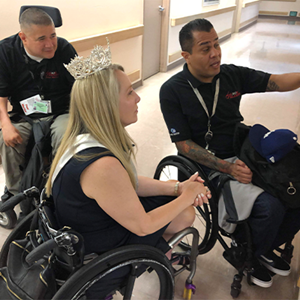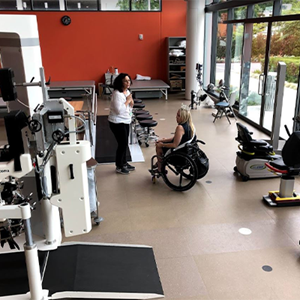.png?width=300&height=300)
Why aren’t more people with disabilities employed? According to the Bureau of Labor Statistics, only 19 percent of people with disabilities were employed in 2018. Wouldn’t it be great if you could use your experience as a person with a disability to help others, and get paid? After I was shot my sophomore year in college and became a T10 paraplegic, I knew that having a career would be important to the way I felt about myself.
Rancho Los Amigos National Rehabilitation Center (RLANRC)has a program called
KnowBarriers; which offers peer mentor and life coaching services to their patients. This program trains and hires former patients; providing former patients a sense of positive self-worth. They have created an organization where people with disabilities not only learn how to be self-sufficient through rehabilitation, but can also become paid peer mentors.
Last month I had the honor of being able to tour their facility as Ms. Wheelchair America. It was amazing to see their unique approach to care, but also how the facility was operated – all keeping people with disabilities at the forefront.
Employment = Empowerment

On my tour I was inspired to see a hospital full of employees who use wheelchairs for mobility. There was a sense of pride and joy throughout Rancho Los Amigos that I have never seen before. The KnowBarriers program gives people the chance to work and to live their best Life Possible!
My experience started in the Rancho Works Café where I was greeted by employees who told me they had previously been patients. My next stop was the Resource Center where ALL of the employees are former patients who have been trained as KnowBarriers Peer Mentors. I spoke with Juan, who explained to me that working for KnowBarriers was a dream come true and he found the work to be the most rewarding of his career.
It reminded me of how important my career is to me, but really how important it is to feel like you have an identity and purpose. I became disabled early in my college career, before I formed my identity. I didn’t know who I was or what I wanted to be when I grew up. Obviously, becoming a paraplegic further complicated my sense of self-identity and self-worth. One of the ways I coped was finding what I
COULD do, taking the focus off what I
couldn’t do. I returned to college part-time - attending classes and moving toward my goal of graduation made me feel productive. Each semester I completed filled me with pride. Earning my undergraduate degree and master’s degree in a wheelchair gave me the confidence I need to go out into the world and find a job.
I eventually found a career in hospital social work and was able to combine my education with my life experience to help others. I was no longer just that poor girl who was shot and paralyzed. I was a Licensed Clinical Social Worker, a wife and a mother! My career gave me a sense of pride and purpose I had never known before.
This is the reason I am so impressed with the KnowBarriers Program. They are providing a purpose to so many, a difference that is immeasurable. It is most certainly a program worth duplicating all over the country – and not just at rehab facilities.
Mentoring each other
“You can’t understand someone until you’ve walked a mile in their shoes.” For those who are newly disabled and can no longer walk, this sentiment rings both true and false. In the early stages of hospitalization people don’t always listen to medical professionals because they haven’t been in their shoes (or wheels). Patients often say to able bodied professionals, "You can walk and have no idea how I feel." In those situations, there is no one better to give advice than someone with a disability.

This is why the Know Barriers Life coaching and peer mentoring program is so effective. This innovative program hires people who have survived a severe injury or illness and provides them extensive training in active listening, goal setting, problem solving and community resources. Peer Mentors who complete the training and their competencies begin working as volunteers and have the option to become independent contractors hired to work for KnowBarriers at RLANRC. Know Barriers peer mentors serve patients in both the inpatient and outpatient facilities.
The survivors that work for KnowBarriers serve as role models to the patients at Rancho. It was such a pleasant and positive environment to visit. Seeing so many people in one place who are employed and thriving is encouraging to someone with a new injury. I talked to many of the KnowBarriers Peer Mentors and they all said this program has brought nothing but positivity to their lives. It is one thing to talk about employing people with disabilities and another to actually do it! I think all rehabilitation hospitals, and businesses in general, should ask themselves why they are not doing the same thing Rancho is.
I myself am currently a certified peer mentor with United Spinal Association. Being a mentor is a privilege because you are being invited into a person’s life at a very difficult time. When you do it right, like they are at Rancho, the mentor/ mentee relationship can last a lifetime. The mentee is often glad to have someone who is not part of their medical team to talk to. There are sometimes questions a mentee has that they want to ask someone living with a disability, rather than a nurse or a doctor. The mentor/ mentee relationship is confidential and very personal information can be shared in a safe environment.
Being a peer mentor has been one of the most rewarding roles of my life. If you are interested in becoming a mentor, or you would like to find one, you can go to
United Spinal Association or the
Christopher and Dana Reeves Foundation.
Supporting each other
During my visit I also had the pleasure to visit the
Don Knabe Wellness Center where people from the community come to work out in a completely wheelchair friendly gym. The gym has weight lifting machines and functional electrical stimulation bikes for anyone to use. I was impressed with the wide range of work out equipment available and the number of people utilizing the facility. It was refreshing to see so many wheelchair users in one place working out. It is nice to be in a space where you are not different because of your disability, rather it’s what makes you fit in!
I work out at home because there is no place in Louisiana where I can find the equipment I need, so I miss out on learning new exercises from my peers and on making new friends. I have always been afraid to go to a “regular” gym because I sometimes need assistance to transfer on/off the machines. The Don Knabe Wellness Center has trained staff to assist the patrons if needed. The people I met there felt very fortunate to have such a state-of-the-art facility in their neighborhood.
Building community
After meeting so many smiling faces and enjoying Rancho’s amazing facility, what struck me most is that it was more than a rehab facility, it was a community. A community that puts wheelchair users at the forefront of everything. (Hello two levels of handicap parking places – my dream come true!) But at the end of the day, it’s the people who make it unlike anywhere else. Everyone is an equal, encouraging all to live their best #lifepossible.
If you ever have a chance to visit Rancho Los Amigos National Rehabilitation Center, I highly recommend it! I have been invited back for their annual
Spinal Injury Games in September, and I can't wait to see my new friends again!